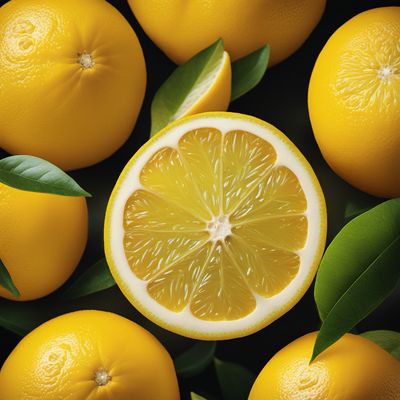
Ingredient
Lemons and similar-
The Zesty Citrus Delight
Lemons and similar ingredients, such as limes and citrons, are citrus fruits known for their vibrant yellow color, sour taste, and fragrant aroma. They have a juicy flesh and a thin, acidic rind that adds a tangy kick to both sweet and savory dishes. With their versatile nature, they are commonly used in beverages, dressings, marinades, desserts, and as a garnish.
Origins and history
Lemons and similar ingredients have a rich history dating back to ancient times. They are believed to have originated in Southeast Asia and were introduced to the Mediterranean region by Arab traders. Lemons have been cultivated for centuries and have played a significant role in various cultures and cuisines. They were highly valued by sailors for their ability to prevent scurvy during long sea voyages. Today, lemons are widely grown in countries like Spain, Italy, the United States, and India.
Nutritional information
Lemons and similar ingredients are low in calories and are a good source of vitamin C, providing a boost to the immune system. They also contain small amounts of other essential vitamins and minerals, including potassium and vitamin B6.
Allergens
Lemons and similar ingredients are not known to be common allergens, but some individuals may be sensitive to citrus fruits and should exercise caution.
How to select
When selecting lemons and similar ingredients, choose fruits that are firm, heavy for their size, and have a bright yellow color. Avoid any with soft spots, blemishes, or a dull appearance, as these may indicate age or spoilage. Additionally, select lemons that feel slightly soft when gently squeezed, as they tend to be juicier.
Storage recommendations
To maintain the freshness of lemons and similar ingredients, store them at room temperature for up to a week. For longer storage, place them in a plastic bag and refrigerate, where they can last for up to a month. To extend their shelf life, you can also freeze the juice or zest for future use.
How to produce
Lemons and similar ingredients can be grown in home gardens or containers, provided they receive adequate sunlight and well-drained soil. They are typically propagated from seeds or cuttings, and with proper care, they can thrive in a variety of climates.
Preparation tips
Lemons and similar ingredients can be used in a multitude of ways in the kitchen. Squeeze the juice to add a tangy flavor to beverages, dressings, and marinades. The zest can be grated and used to enhance the aroma and taste of baked goods, sauces, and desserts. Thin slices of lemon can be used as a garnish or added to dishes for a burst of freshness.
Substitutions
Limes, citrons, and other citrus fruits can be used as substitutes for lemons, depending on the desired flavor profile of the dish. However, keep in mind that each citrus fruit has its own unique taste and acidity level, so adjustments may be needed in recipes.
Culinary uses
Lemons and similar ingredients are widely used in both sweet and savory dishes. They are commonly found in lemonade, lemon meringue pie, lemon bars, lemon chicken, lemon pasta, and various Mediterranean and Asian cuisines. They are also a popular ingredient in cocktails and refreshing summer beverages.
Availability
Lemons and similar ingredients are cultivated in many regions around the world, including Spain, Italy, the United States, Mexico, and India.


